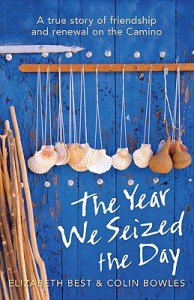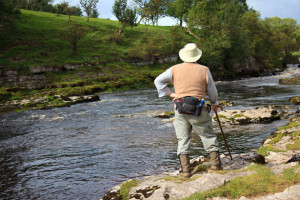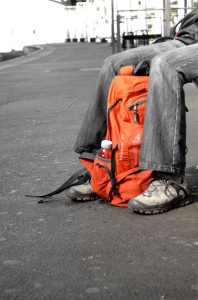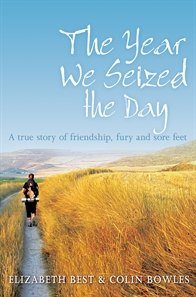Travel writers can effectively borrow from fiction, using narrative techniques and literary devices to improve their non-fiction writing. Creative non-fiction is engaging as well as informative. In my critique of ‘The Year We Seized the Day’ by Elizabeth Best and Colin Bowles, I examine the techniques these authors use to sweep readers up in the story of their journey.
In his article ‘Roads Not Taken’ (2001), Thomas Swick concludes, “Enlightenment and love – there are no more compelling reasons to travel, or write about it.” Authors Elizabeth Best and Colin Bowles spent 36 days walking the Camino, through Spain. Though far from being religious pilgrims, both were physically, emotionally and spiritually transformed by days spent in contemplation of their own lives and witnessing the wonders of humanity along this old pilgrim route. In reading their book, ‘The Year We Seized the Day’, the reader is swept along with each step. Through the use of a day-by-day episodic narrative structure, intimate characterisation of themselves, enlightening observations of those they met along the way, and the humour that they bring to what was a life changing journey, the reader is able to access the transformation undergone by Best and Bowles. “Travelers are everywhere, but great travel writers from Marco Polo to Mark Twain and Bruce Chatwin all knew that a reader’s attention needs to be gripped with vivid anecdotes, humor, narrative – in short, good storytelling.” (Perrottet, T, 2009). In ‘The Year We Seized the Day’, both Best and Bowles engage their readers through the use of effective strategies: engaging the readers through their use of imagination, characterisation and humour.
.
 The imaginative devices that Best and Bowles utilise in ‘The Year We Seized the Day’ to structure the book and engage the reader are similar to both fictional narrative and journal writing. Best and Bowles take turns at writing entries and these are then organised in a chronological, day-by-day account of their 36 days of walking. Swick says that one thing that distinguishes travel writing from tourism and takes the writing “…beneath the surface…” is the use of creative imagination and the use of elements of fiction writing. At its most basic, the structure of fiction writing in this book includes an orientation, that provides the background context and gives the reader insight into how the journey came about and the relationship between the two; a problem, in the form of the sheer difficulty of undertaking such a trek and the problems faced by each writer; a climax for each writer – that make or break moment where quitting is a real option; and, the resolution, in which we see each writer complete their pilgrimage. However, this wholeness, this completed story, is made up in itself of a number of smaller episodes in the form of each written entry. These episodes are unified in the whole book by the core idea of the pilgrimage. “Whether you believe it or not, there’s something uniquely moving about the Camino.” (Best, 2009) It is only through reading all the episodes that the reader can imagine or feel the accomplishment of pilgrims having finally arrived at their destination. These fragments of story each contain a mini-narrative, an anecdote within the structure of the whole story. Each fragment contains within it an orientation, problem, climax and resolution and this serves to hold the readers’ attention in an ever undulating wave of experience and emotion. At times, these smaller moments feel fragmented for the reader and unsettles the reader in much the same way that the writers experienced their own journey, which was disrupted by injury, by internal and external conflict, by separation and isolation and was punctuation by small towns and paths crossed with fellow travelers. This narrative structure of episodic writing enhances the feeling of fragmentation for the reader, thus enabling the reader to feel something of the experience itself. “For the first time I am frightened to be on my own. I don’t like my own company. I don’t understand what is happening to me. The Meseta…has made me a little crazy… And let me tell you something… It’s not that far from there to here.” (Bowles, 2009) With each step, each word, the reader is drawn along this journey in a process of discovery. Through each written entry the reader is given a new piece of information that, in time, creates the whole story. For example, the reader gradually witnesses Bowles becoming more and more lost as his emotions unravel, slowly discovering that he had an affair and, after leaving his wife, she committed suicide and it is this ghost that haunts his conscience. These more difficult emotions are offered alongside the physical highs and lows of the journey and it is this conveying of these more negative aspects that make the story that makes the writers more ‘real’ for the reader.
The imaginative devices that Best and Bowles utilise in ‘The Year We Seized the Day’ to structure the book and engage the reader are similar to both fictional narrative and journal writing. Best and Bowles take turns at writing entries and these are then organised in a chronological, day-by-day account of their 36 days of walking. Swick says that one thing that distinguishes travel writing from tourism and takes the writing “…beneath the surface…” is the use of creative imagination and the use of elements of fiction writing. At its most basic, the structure of fiction writing in this book includes an orientation, that provides the background context and gives the reader insight into how the journey came about and the relationship between the two; a problem, in the form of the sheer difficulty of undertaking such a trek and the problems faced by each writer; a climax for each writer – that make or break moment where quitting is a real option; and, the resolution, in which we see each writer complete their pilgrimage. However, this wholeness, this completed story, is made up in itself of a number of smaller episodes in the form of each written entry. These episodes are unified in the whole book by the core idea of the pilgrimage. “Whether you believe it or not, there’s something uniquely moving about the Camino.” (Best, 2009) It is only through reading all the episodes that the reader can imagine or feel the accomplishment of pilgrims having finally arrived at their destination. These fragments of story each contain a mini-narrative, an anecdote within the structure of the whole story. Each fragment contains within it an orientation, problem, climax and resolution and this serves to hold the readers’ attention in an ever undulating wave of experience and emotion. At times, these smaller moments feel fragmented for the reader and unsettles the reader in much the same way that the writers experienced their own journey, which was disrupted by injury, by internal and external conflict, by separation and isolation and was punctuation by small towns and paths crossed with fellow travelers. This narrative structure of episodic writing enhances the feeling of fragmentation for the reader, thus enabling the reader to feel something of the experience itself. “For the first time I am frightened to be on my own. I don’t like my own company. I don’t understand what is happening to me. The Meseta…has made me a little crazy… And let me tell you something… It’s not that far from there to here.” (Bowles, 2009) With each step, each word, the reader is drawn along this journey in a process of discovery. Through each written entry the reader is given a new piece of information that, in time, creates the whole story. For example, the reader gradually witnesses Bowles becoming more and more lost as his emotions unravel, slowly discovering that he had an affair and, after leaving his wife, she committed suicide and it is this ghost that haunts his conscience. These more difficult emotions are offered alongside the physical highs and lows of the journey and it is this conveying of these more negative aspects that make the story that makes the writers more ‘real’ for the reader.
.
 The characterisation of the writers as pilgrims and of those they meet along the way serves to create intimacy and honesty so that the reader is able to bond with and learn from the events. “We learn through human contact…,” Swick asserts that it is through writing about the local people that you become, “…immersed in a crush of humanity…” It is through the use of the first person subjective point of view that the reader gets a sense of life on the Camino and insight into the frailty and beauty of humanity. When describing fellow pilgrims, Simon and Mercedes, Best writes, “They’re a rare couple, generous, honest and authentic. The kind of people you instantly warm to.” She takes this insight about the couple and goes further to create an image of the pilgrim as a being, “The bond between pilgrims is one based on respect. It takes a certain personal quality to set yourself such a challenge and the nature of people you meet generally reflects some aspect of the humility that the trail demands.” In this way, Best uses the Camino as a metaphor for all whom she encounters enabling her to draw comparison and add life and personality not just to the people she meets, but to the Camino itself. Both Bowles and Best intersperse their descriptions and reflections with snatches of dialogue. Swick likens writing without dialogue to, “…moving through a landscape of mimes – figures are sensed, sometimes even seen, but almost never heard from.” Bowles tends to use dialogue to dramatise an incident rather than to allow voice to local character. For example, after nine days of walking he develops tendonitis. In three lines of included dialogue, another pilgrim reveals what happened to their friend with the same problem, “his foot had to be amputated.” This snippet reveals nothing about the fellow traveler, serving merely to add drama to Bowles’ own journey. Best, on the other hand, includes dialogue to show something about each character, to capture the spirit of place or to show some insight into those who make the pilgrimage. When she writes of the friendliness and afforded to pilgrims, she recollects her interaction with a young Spanish boy, “Do chew need hell-up with somethink? … Unless chew want to be alone of course? Some pilgrims are strange, they don’t like to speak, they wish to be left alone.” In this way she captures a helpfulness that exists despite the difficulty of cross language understanding. Best writes phonetically to capture the distinctive accent of this boy and bring humour to her writing.
The characterisation of the writers as pilgrims and of those they meet along the way serves to create intimacy and honesty so that the reader is able to bond with and learn from the events. “We learn through human contact…,” Swick asserts that it is through writing about the local people that you become, “…immersed in a crush of humanity…” It is through the use of the first person subjective point of view that the reader gets a sense of life on the Camino and insight into the frailty and beauty of humanity. When describing fellow pilgrims, Simon and Mercedes, Best writes, “They’re a rare couple, generous, honest and authentic. The kind of people you instantly warm to.” She takes this insight about the couple and goes further to create an image of the pilgrim as a being, “The bond between pilgrims is one based on respect. It takes a certain personal quality to set yourself such a challenge and the nature of people you meet generally reflects some aspect of the humility that the trail demands.” In this way, Best uses the Camino as a metaphor for all whom she encounters enabling her to draw comparison and add life and personality not just to the people she meets, but to the Camino itself. Both Bowles and Best intersperse their descriptions and reflections with snatches of dialogue. Swick likens writing without dialogue to, “…moving through a landscape of mimes – figures are sensed, sometimes even seen, but almost never heard from.” Bowles tends to use dialogue to dramatise an incident rather than to allow voice to local character. For example, after nine days of walking he develops tendonitis. In three lines of included dialogue, another pilgrim reveals what happened to their friend with the same problem, “his foot had to be amputated.” This snippet reveals nothing about the fellow traveler, serving merely to add drama to Bowles’ own journey. Best, on the other hand, includes dialogue to show something about each character, to capture the spirit of place or to show some insight into those who make the pilgrimage. When she writes of the friendliness and afforded to pilgrims, she recollects her interaction with a young Spanish boy, “Do chew need hell-up with somethink? … Unless chew want to be alone of course? Some pilgrims are strange, they don’t like to speak, they wish to be left alone.” In this way she captures a helpfulness that exists despite the difficulty of cross language understanding. Best writes phonetically to capture the distinctive accent of this boy and bring humour to her writing.
.
 Another method Swick says travel writers can use to engage their audience through is the use of humour. Humour enables writers to laugh at themselves and thereby allowing the reader to see the writer as ‘human’ and to recognise the hilarity or absurdity of particular situations or experiences. After being kicked out of a monastery for sleeping in, Bowles writes, “A lifetime of charity and humility and Christian service notwithstanding, Mother Mary slams the heavy oak and iron door in our faces. I swear I saw her give me the finger in the instant before the door shut with a booming thud.” The juxtaposition of the image of a nun, who has dedicated her life in the service of others, against the image of Bowles, being unceremoniously kicked out of the monetary, brings a lightness to Bowles’ usual black humour. Bowles sets out on the Camino in the role of mentor, leading the way, but quickly unravels to become the reverse of the historically traditional view of male traveler as the bold explorer, as he struggles to deal with a lack of emotional control. The humour portrayed by Bowles here is particularly black, but does provide some relief from the intensity of Bowles’ internal struggle. On the other hand, Best’s use of humour enables her to laugh in the face of adversity and to shed light on the more difficult aspects of the journey. The biggest hurdles for pilgrims are injuries and Best, though determined, is plagued by swollen knees and blistered feet, plagued by a body she is not certain can complete the pilgrimage. “My body struggles… My knee is buggered… The next morning, I strap my knee, bandage my feet, take two asprin, an anti-inflammatory and one of those fantastic pink pills Mercede’s uncle prescribed, then set off…” By highlighting the ridiculousness of the situation, Best is able to discuss the most negative aspects of her journey. The effect of this makes her struggle more ‘real’ for readers, and far more inspiring than if this had been omitted.
Another method Swick says travel writers can use to engage their audience through is the use of humour. Humour enables writers to laugh at themselves and thereby allowing the reader to see the writer as ‘human’ and to recognise the hilarity or absurdity of particular situations or experiences. After being kicked out of a monastery for sleeping in, Bowles writes, “A lifetime of charity and humility and Christian service notwithstanding, Mother Mary slams the heavy oak and iron door in our faces. I swear I saw her give me the finger in the instant before the door shut with a booming thud.” The juxtaposition of the image of a nun, who has dedicated her life in the service of others, against the image of Bowles, being unceremoniously kicked out of the monetary, brings a lightness to Bowles’ usual black humour. Bowles sets out on the Camino in the role of mentor, leading the way, but quickly unravels to become the reverse of the historically traditional view of male traveler as the bold explorer, as he struggles to deal with a lack of emotional control. The humour portrayed by Bowles here is particularly black, but does provide some relief from the intensity of Bowles’ internal struggle. On the other hand, Best’s use of humour enables her to laugh in the face of adversity and to shed light on the more difficult aspects of the journey. The biggest hurdles for pilgrims are injuries and Best, though determined, is plagued by swollen knees and blistered feet, plagued by a body she is not certain can complete the pilgrimage. “My body struggles… My knee is buggered… The next morning, I strap my knee, bandage my feet, take two asprin, an anti-inflammatory and one of those fantastic pink pills Mercede’s uncle prescribed, then set off…” By highlighting the ridiculousness of the situation, Best is able to discuss the most negative aspects of her journey. The effect of this makes her struggle more ‘real’ for readers, and far more inspiring than if this had been omitted.
.
 By engaging the reader in the book, in the produced story, readers are able to access the transformation that both authors experienced along their journey and are, potentially, inspired to make their own. James O’Reilly wrote, “…the journey strips away the illusions of self…” (2009), but it is only through engaging writing that the reader can access this sense of knowing, of truth, of enlightenment. Bowles and Best engaged their readers through the use of imaginative use of elements of fictional narrative structure, by making insightful observations about themselves and those they meet on their journey, through carefully chosen and crafted snippets of conversation and by finding humour in trying circumstances. Their honesty enabled a ‘warts and all’ depiction of the life of a pilgrim on the Camino in a way that is entertaining, informative, inspiring and transformational. “Wandering re-establishes the original harmony which once existed between man and the universe.” Anatole France. (The Best Travel Writing, 2009)
By engaging the reader in the book, in the produced story, readers are able to access the transformation that both authors experienced along their journey and are, potentially, inspired to make their own. James O’Reilly wrote, “…the journey strips away the illusions of self…” (2009), but it is only through engaging writing that the reader can access this sense of knowing, of truth, of enlightenment. Bowles and Best engaged their readers through the use of imaginative use of elements of fictional narrative structure, by making insightful observations about themselves and those they meet on their journey, through carefully chosen and crafted snippets of conversation and by finding humour in trying circumstances. Their honesty enabled a ‘warts and all’ depiction of the life of a pilgrim on the Camino in a way that is entertaining, informative, inspiring and transformational. “Wandering re-establishes the original harmony which once existed between man and the universe.” Anatole France. (The Best Travel Writing, 2009)
BIBLIOGRAPHY
Bassnett, S 2002, ‘Travel writing and gender’, in P Hulme and T Youngs (eds), The Cambridge companion to travel writing, Cambridge University Press, UK, pp. 225-41.
Best, E and Bowles, C, The Year We Seized the Day, Allen and Unwin, Australia, 2007.
France, A in The Best Travel Writing, Solas House, Inc., California, pp. vii.
O’Reilly, J 2009, ‘Publisher’s Preface’, in The Best Travel Writing, Solas House, Inc., California, pp. xiii-xv.
Perrottet, T 2009, ‘Introduction’, in The Best Travel Writing, Solas House, Inc., California, pp. xvi-xiix.
Swick, T 2001, ‘Roads Not Taken’, Columbia Journalism Review, vol. 40, no. 1, pp. 65-7, retrieved 6 April 2009, Expanded Academic ASAP database.
.
For more about Colin Bowles (AKA Colin Falconer), see his blog: Looking for Mr Goodstory
.
Photo credit: adventurer
Photo credit: travel




Pingback: Life Writing: Borrowing From Fiction :: Shel SweeneyShel Sweeney
Pingback: Life Writing: Borrowing From Fiction - A Worded Life